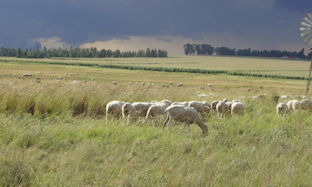
SHEEP MANAGEMENT PRE-LAMBING: General management aspects
This is article 6 of 6 articles on this topic
In the previous articles in this series on sheep management in late pregnancy, the following aspects were discussed - introductory thoughts, nutrition/condition, vaccination, trace mineral supplementation and parasite control. In the final article, some general management aspects are dealt with in the run-up to the lambing season, which can help to make the lambing process run as smoothly as possible. The following points should receive attention:
-
Classify the ewes according to condition and/or pregnancy status if this has not already been done. Adjust the nutrition of ewes whose condition is not optimal, as well as that of the ewes carrying multiples, to be in a condition point of at least 3.5 at lambing.
-
Work as calmly as possible with heavily pregnant ewes
-
limit stress as far as possible during handling
-
ewes must be driven calmly to and from the handling facilities
-
handling facilities must be of such a standard as to make it possible to work calmly
-
avoid bruises or injuries during handling to prevent abortions
-
workers must also be trained to work with the animals as calmly as possible
-
water must be available nearby at all times
-
if ewes have to spend the night in the pen in exceptional circumstances, fresh drinking water and feed (hay) must be available
-
-
Improve supervision of late pregnant ewes. Look out for ewes that lie down and cannot get up to be helped up to prevent deaths.
-
Plan the lambing camps and make sure that the fences and water supply are in order.
-
If the lambs are going to be given creep feed, it must be ensured that the feed troughs and creep gates are in order.
-
If vermin are a problem during lambing, work must be done early on to reduce the numbers of vermin and make sure that fences (jackal proof) or other deterrents are in good working order or implemented.
-
If lambing pens are used, it must be ensured that:
-
the pens are properly disinfected
-
the water supply and food bowls are sufficient and in working condition
-
the bedding is sufficient
-
shade and windbreaks are in order (if lambing takes place in an open facility)
-
ensure that the ration used for adaptation and to be fed to the ewes whilst in the lambing pens, is ordered in advance or mixed timely
-
Watch out for abortions in late pregnancy. Any aborted fetus should be taken to the vet as soon as possible and sent away for examination to try to determine the cause.
-
Watch out for metabolic diseases e.g.
-
"Domsiekte" (pregnancy toxemia) - ewes' rumen space becomes restricted (especially in ewes carrying multiple foetus’s), which limits nutrient intake. Ewes break down body fat to try to meet energy needs and this can lead to the build-up of ketones which cause domsiekte. The quality of nutrition during late pregnancy is of crucial importance.Treatment is not very effective but a supplement (dosing) of rapidly available energy can be tried.
-
Milk fever - subclinical milk fever can occur just before and after lambing, with ewes being lethargic and struggling during the lambing process. In clinical cases, the ewes lie down with a characteristic head-on-the-shoulder posture and do not respond to any stimulus. An injectable calcium/magnesium/phosphate supplement can work wonders
-
A condition known as "grass staggers" - may occur on lush planted pastures and is the result of a magnesium deficiency. Ewes may be lethargic, unsteady on their feet or appear hyperstimulated. Treat affected animals immediately with a calcium/magnesium supplement and provide hay along with the pasture.
-
-
If wool breeds are shorn in late pregnancy, the ewes must be handled very carefully during the shearing process. It is also recommended that ewes are not shorn less than 6 weeks before lambing.
-
Make sure that the "first aid kit" is filled with the essentials for use during lambing time.

